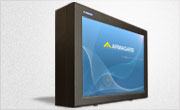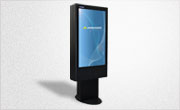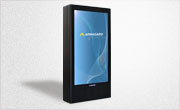Don’t be Dim – Importance of Brightness for Outdoor Digital Signage
Posted by: Richard Williams | Posted on: | 0 Comments
Outdoor digital signage is a fast growing and compelling industry. With huge audience potential, placing a screen in an outdoor location can generate far more interest than a static advertisement or even a comparative indoor digital signage campaign.
Although, being a new industry there are a lot of common mistakes. Protection is perhaps the most common, while few fail to forget about the weather or vandalism protection, often temperature can be forgotten about, but a far less obvious facet of outdoor digital signage is often overlooked – the importance of screen brightness.
High Brightness
Daylight has a tendency to wash out standard LCD displays. The sun’s rays can overpower the brightness of the display making it hard to read; furthermore, when the sun is shining directly onto the screen it can cause glare making the screen even harder to read.
The brightness of LCD screens is commonly measure in units of nits or candela (both units are the same) which represents the umber of candles it would take to accumulate such brightness. Most standard LCD devices generate a nit rating of around 500 but a good outdoor screen needs to have at least twice that to overcome the problems of above.
LED backlights
Traditional LCD displays have a fluorescent back light, which means the brightness of the image is amplified by fluorescent tubes. These just aren’t strong enough for outdoor digital signage and outdoor screen use but there alternatives.
LED backlights have a bank of LEDs that generate the brightness of the screen. These LED back-lit LCD displays can generate a much higher brightness than fluorescent tubes and are therefore far better for outdoor displays. They do have one drawback, however, and that is that they generate far more heat so additional cooling has to be installed in the outdoor digital signage enclosure
Reactive screens
Some modern outdoor screens actually take advantage of the sun’s rays. Transflective screens run as similar nit levels to regular LCD displays when they are operating under normal conditions but when the intensity of daylight increases, the transflective screen uses the sun’s own rays to boost the brightness of the screen, often exceeding 1500 nits – so the brighter the sun – the brighter the display.
Both these methods provide a far better solution for an outdoor display than standard commercial grade screens and will ensure your message does not get washed out by the sun.
Post shortlink:
Popular Products
LCD Enclosure
Need armor for your LCD/LED screen(s)? Outdoors or inside the versatile LCD enclosure protects against thieves, vandals & the weather. Installation idea: NFL stadiums.
Outdoor Digital Signage
Exclusive 46” outdoor screen protection. Dubbed the ‘Totem’, due to its distinct design, it repels damage threats, but attracts audiences. Installation idea: Drive-thru restaurants.
Portrait Flat Panel Enclosure
Safeguard your eye-level advertising display screen(s), indoors or outdoors. Completely customizable, add exciting features like touch screen technology. Installation idea: Restaurant frontages.
Indoor Digital Signage
Popular purchase for retail outlets! Great for ‘point of sale’ persuasion, boost your brand with static & motion advertising from a single unit! Installation idea: Mall of America.





